This delicious and easy-to-make Venezuelan Sancocho is filled with vegetables, starches, and hearty beef! It is the perfect Sunday dish to enjoy with family and friends.
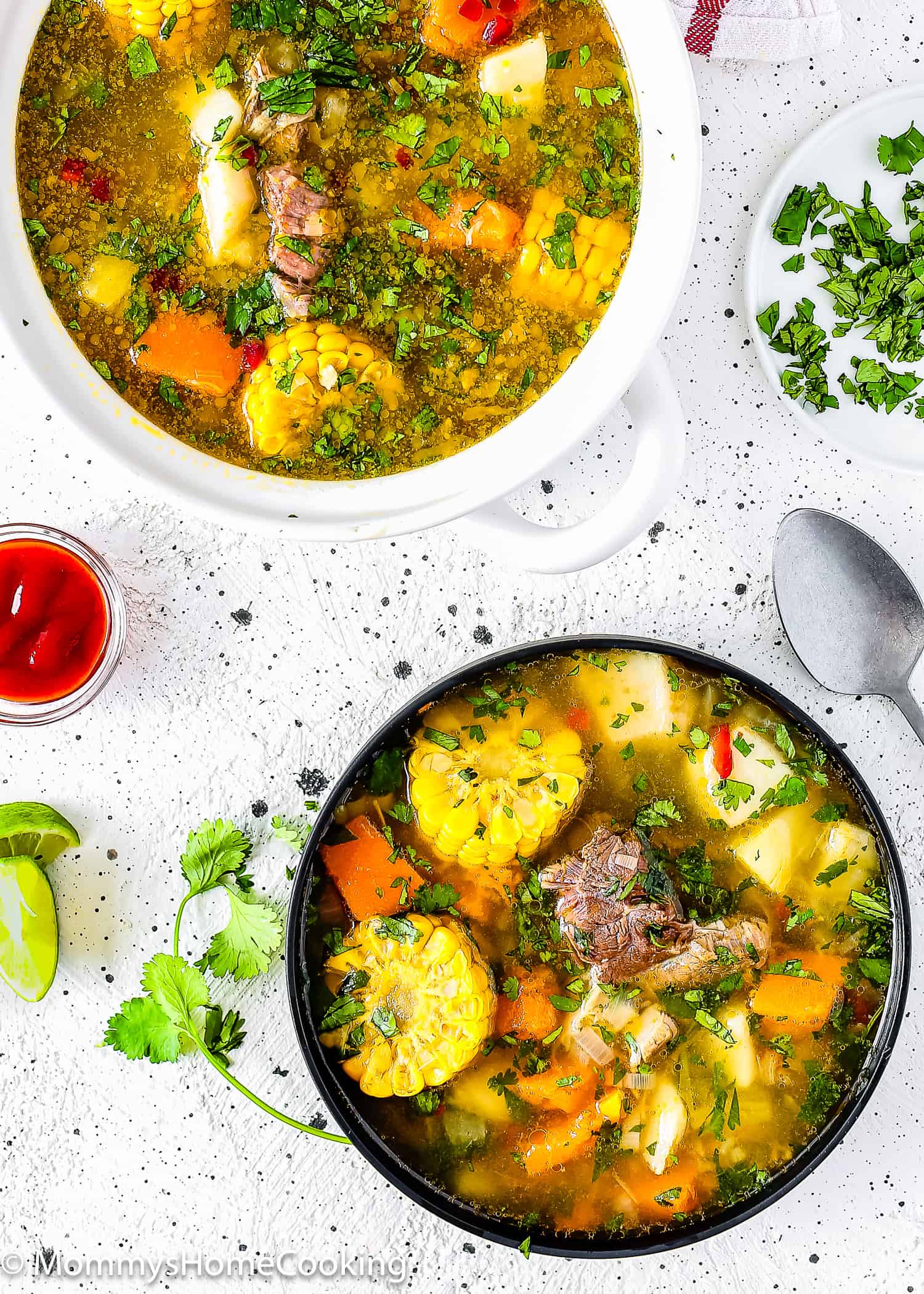
My Family’s Venezuelan Sancocho Recipe
Venezuelan Sancocho is a dish that warms my soul! Every time I feel homesick, I prepare a big ol’ pot of this hearty soup, some arepas with nata, and my nostalgia is cured.
My mom used to make Sancocho almost every Sunday, which is why it reminds me of home. And while there’s no panacea for homesickness, this Venezuelan sancocho comes damn close.
This hearty and absolutely delicious soup is made with hind shank (a.k.a Lagarto con hueso) and a variety of vegetables and starches.
Venezuelan cuisine has a wide repertoire of delicious and hearty soups, such as Mondongo, Sopa de Rabo, among others.
Give this Venezuelan Sancocho recipe a try soon! It’s cozy, comforting, healthy-ish, and perfect to share with family and friends.
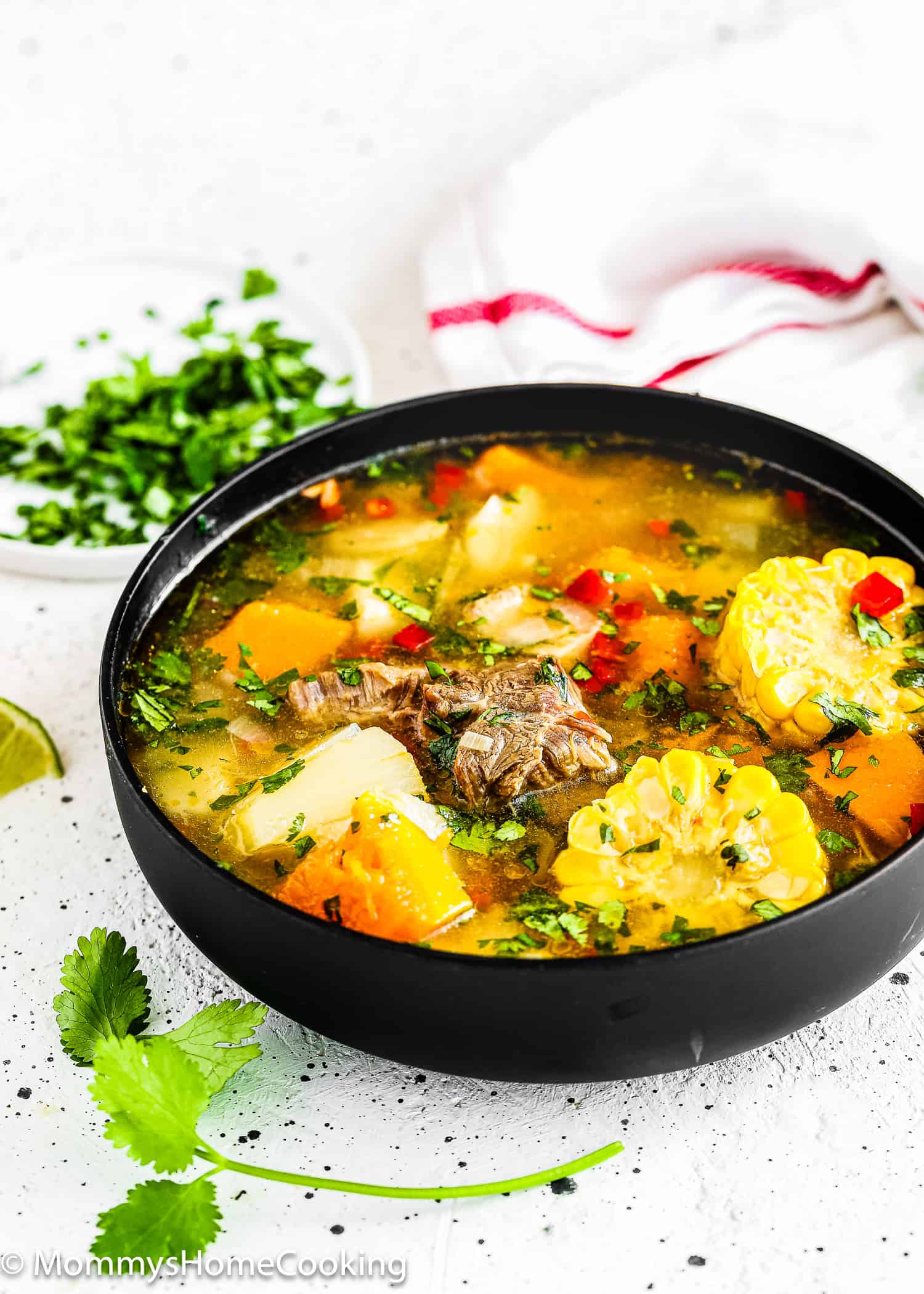
What is Sancocho?
Sancocho is a traditional Latin American and Spanish stew that varies by region. It’s a hearty and flavorful soup often made with a mix of meats, root vegetables, and herbs and spices. The ingredients can differ significantly depending on the country or region in which it’s prepared. Some common ingredients in sancocho can include beef, chicken, pork, or fish, as well as starchy vegetables like yuca (cassava), plantains, potatoes, and corn. Each region adds its own unique flavors and ingredients to the dish.
Sancocho is typically simmered low and slow, allowing all the ingredients to meld together and create a rich, savory broth. It’s often considered a comfort food and is a popular choice for gatherings and celebrations.
The specific recipe and variations of sancocho can differ greatly depending on the country and local culinary traditions. In Latin America, you can find variations of sancocho in countries such as Venezuela, the Dominican Republic, Puerto Rico, Colombia, and several others. Each version reflects the unique flavors and ingredients of the region.
Venezuelan Sancocho Ingredients
Please check the recipe card at the bottom of the post for exact quantities and detailed instructions (scroll down).
Meat: The traditional meat used in Venezuela to make Sancocho is Largarto con Hueso. In the US, this cut of meat is known as Hind Shank.
Stock: Beef or vegetable stock. I prefer vegetable stock so the broth is not too dark.
Vegetables: Onion, garlic, leeks, scallions, bell pepper, mini sweet red pepper, fresh corn, and cilantro.
Root Vegetables: Yuca or Cassava, Yautia (Ocumo), White Yam (Ñame), Butternut Squash (Auyama). I did not add green plantains, but you can add them if you like. The root vegetables can be found in most Latin or Asian stores.
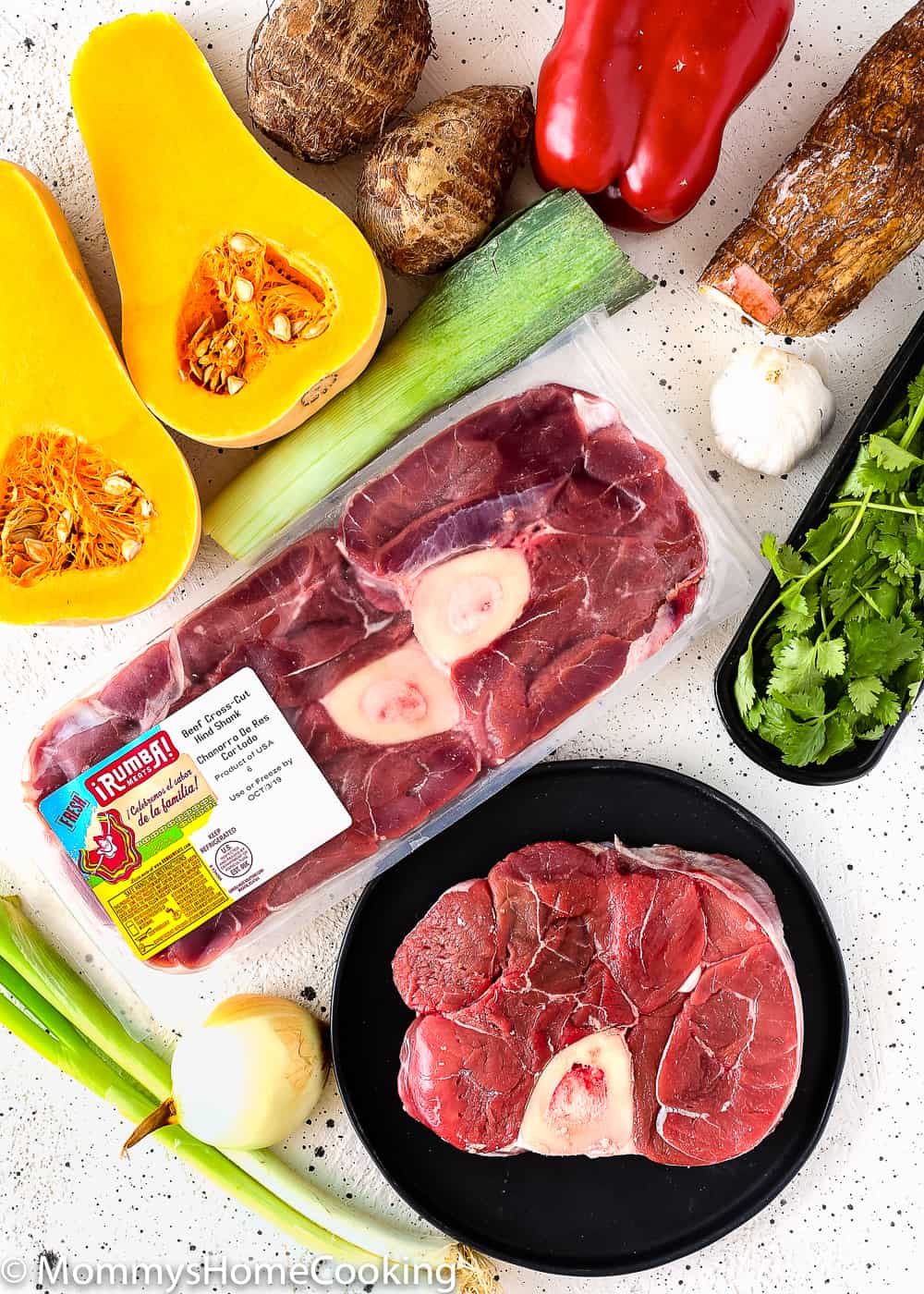
Overview: How to Make Venezuelan Sancocho
Please check the recipe card at the bottom of the post for exact quantities and detailed instructions (scroll down).
- Make a Super Flavorful Broth
When making sancocho, the most important thing is the broth. It has to be full of flavor and delicious. To achieve this, add hind shank, 1 halved small onion, halved bell pepper, 4 whole garlic cloves, the dark green leaves of the leeks, and stock to a large stockpot. Cook for 45-60 minutes until the meat is fork-tender.
- Add Veggies
Add diced onion, garlic, mini sweet peppers, sliced leeks (light green part), scallions, yucca, and corn; mix and simmer covered over medium heat for 5- 8 minutes, until the yucca is starting to soften. Then, add yautia, white yam, and butternut squash. Mix to combine. Simmer covered over medium heat for 5 – 6 minutes, until all the root vegetables are tender. NOTE: Do not cook too much, or they will fall apart.
- Last Step – My Mom’s Secret
2 minutes before turning the heat off, add chopped cilantro and 2 minced garlic cloves. This final step will make your sancocho ultra delicious!
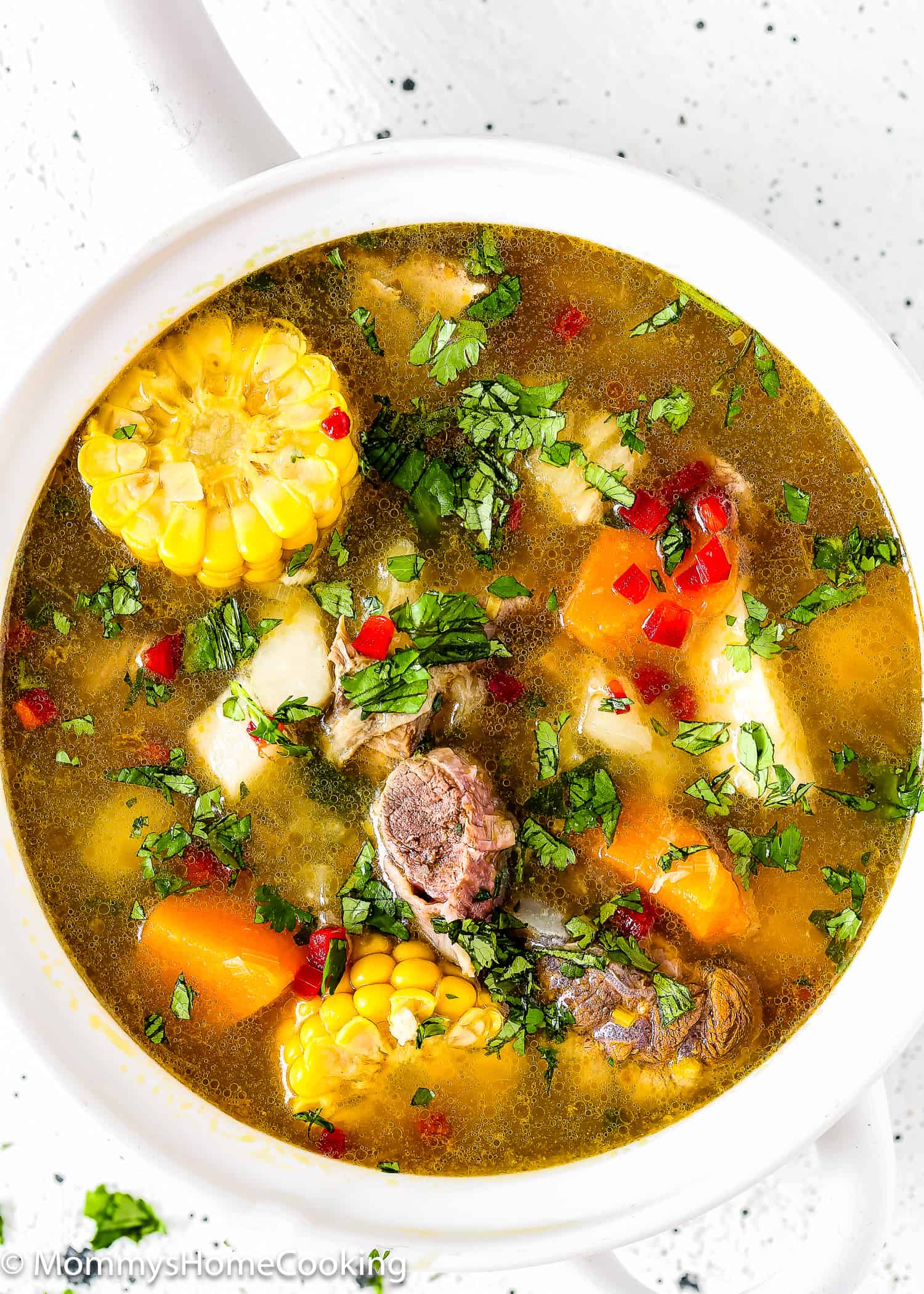
Venezuelan Sancocho Serving Suggestions
Sancocho is a hearty and filling soup/stew that’s typically served as a main course in Venezuela. Here’s how you can serve it:
- Soup Bowl: Sancocho is traditionally served in deep soup bowls or large dishes to accommodate the generous portions. Make sure each bowl contains a balance of meats, vegetables, and broth.
- Garnishes: Set out a variety of garnishes and condiments so diners can customize their sancocho. Common options include chopped fresh cilantro, finely sliced scallions, lime wedges, and aji (a type of hot sauce)or any other hot sauce of your preference.
- Side Dishes: While sancocho is a complete meal on its own, you can enhance the dining experience with some side dishes. Serve it with a side of rice, avocado slices, casabe, or arepas (my favorite).
- Bread: Some people like to enjoy sancocho with crusty bread, such as a baguette or dinner rolls. The bread can be used for dipping into the broth.
- Family Style: Sancocho is often a communal dish, so it’s common to serve it family-style. Place the pot of sancocho in the center of the table along with all the garnishes, and let everyone help themselves.
- Variations: Sancocho can have various regional and individual variations. For instance, you might find seafood sancocho, chicken sancocho, or beef sancocho. Some recipes call for specific accompaniments. Be sure to let your guests know what type of sancocho you’re serving.
The beauty of Sancocho is that it can be customized and enjoyed in different ways, so feel free to adjust it to your preferences or the preferences of your guests. It’s a warm and comforting dish that’s perfect for gatherings and family meals.
Storing & Freezing Instructions
Store
You can store sancocho leftover covered in the refrigerator for up to 3 days. I recommend removing the corn from the soup so there’s no risk that it ferments.
Freeze
To freeze Venezuelan sancocho, let it cool completely and then place it in an airtight container. Freeze sancocho for up to a month. I recommend removing the corn from the soup so there’s no risk that it ferments.
Frequently Asked Questions
Hind Shank.
The traditional cut of beef used in Venezuela is Largarto con Hueso, which you can find in the USA as Hind Shank.
You can store sancocho leftover covered in the refrigerator for up to 3 days. I recommend removing the corn from the soup so there’s no risk that it ferments.
Yes, you can. Let it cool completely, and then place it in an airtight container. Freeze sancocho for up to a month. I recommend removing the corn from the soup so there’s no risk that it ferments.
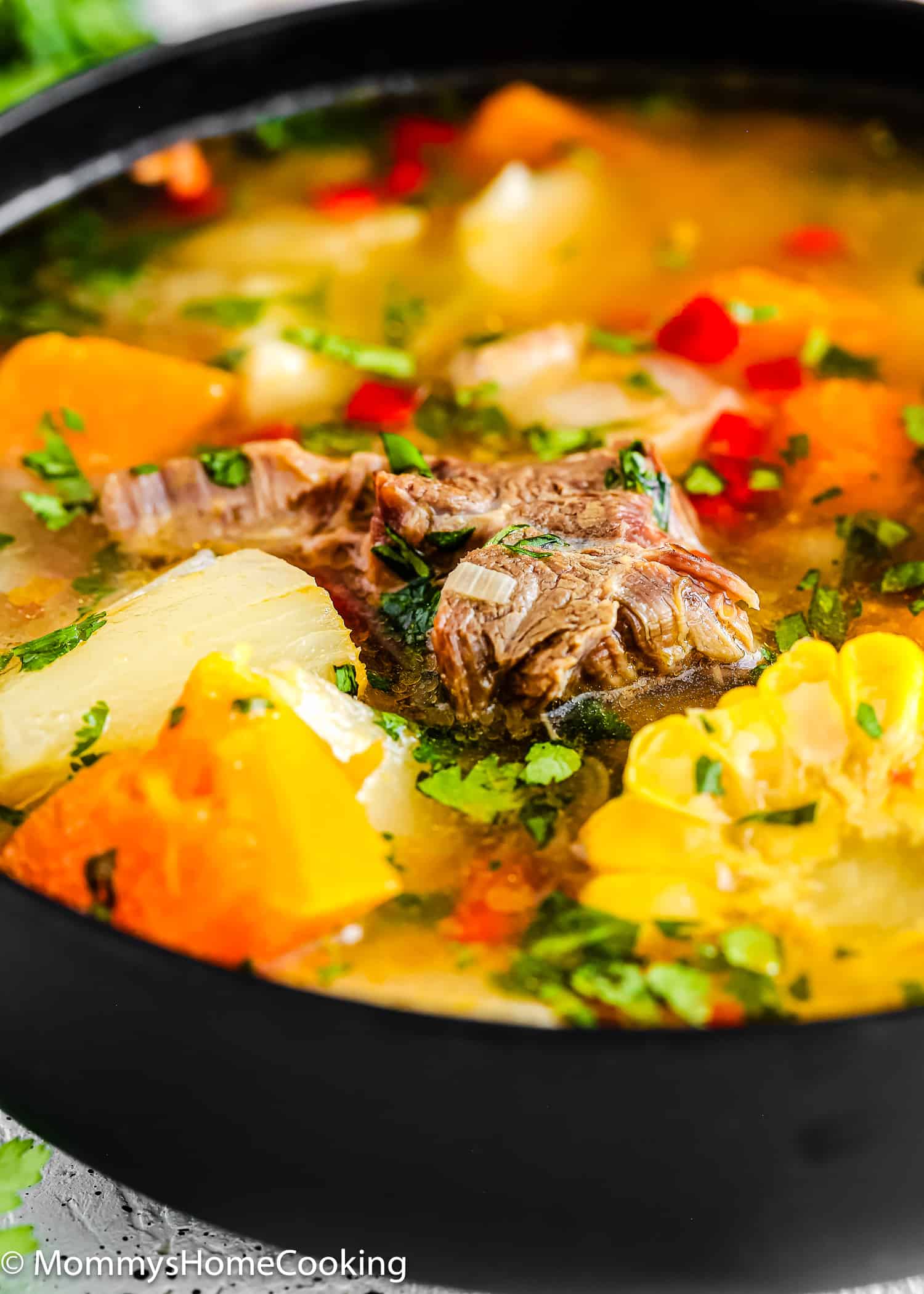
More Venezuelan Recipes You’ll Love!
- Venezuelan Pabellon Bowl [Video]
- Venezuelan Pernil
- Easy No-Bake Venezuelan Bienmesabe
- Venezuelan Polvorosas Cookies
- Eggless Venezuelan Tequeños
- Venezuelan Chocolate Marquesa
- Instant Pot Venezuelan Shredded Beef
❤️ Love what you see? JOIN my Private Baking Club. Also, SUBSCRIBE to Mommy’s Home Cooking, so you’ll never miss a recipe! And FOLLOW along on Instagram, Pinterest, and Facebook for more fun!
Recipe Card 📖
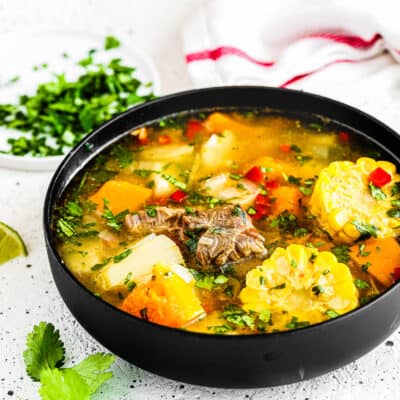
Easy Venezuelan Sancocho
Ingredients
- 1 ½ – 2 lb Hind Shank
- 2 small onions, divided (one halved + one diced)
- ½ bell pepper, halved
- 8 garlic cloves, divided (4 wholes + 4 minced)
- 1 leek, separated (dark green leaves and light part)
- 8 cups beef or vegetable stock
- ½ cup mini red sweet peppers, thinly diced
- ½ cup scallions, sliced
- 2 ears of corn, cleaned and sliced into 4 parts each (you can use frozen if fresh is not available)
- ½ lb Cassaba (Yuca in Spanish) , cut into 1-inch pieces
- ½ lb Yautia (Ocumo in Spanish) , cut into 1-inch pieces
- ½ lb White Yam (Ñame in Spanish) , cut into 1-inch pieces
- ½ lb Butternut Squash (Auyama in Spanish) , cut into 1-inch pieces
- Salt and black pepper to taste (I added 1 teaspoon of salt)
- Cilantro leaves, chopped
Instructions
- Add hind shank, 1 halved small onion, halved bell pepper, 4 whole garlic cloves, the dark green leaves of the leek, and stock to a large stockpot. Cook for 45-60 minutes until the meat is fork-tender. NOTE: the meat can take a bit longer to be fork-tender; that is okay, just add more cooking time if necessary.
- When the meat is tender, remove the big pieces of vegetables and bones. Discard.
- Add diced onion, 2 minced garlic, mini sweet peppers, sliced leeks (light green part), scallions, yucca, and corn; Mix and simmer covered over medium heat for 5- 8 minutes, until the yucca is starting to soften. NOTE: the yuca can take a bit longer to start softening; that is okay, just add more cooking time if necessary.
- Add yautia, white yam, and butternut squash. Mix to combine. Simmer covered over medium heat for 5 – 6 minutes, until all the root vegetables are tender. NOTE: Do not cook too much, or they will fall apart.
- Taste and add salt to your taste, if necessary. Add cilantro and the remaining 2 minced garlic cloves. Mix and let simmer for 2 more minutes.
- Serve hot in large soup bowls, dividing the meat and vegetables evenly. Add a squish of lime juice and/or hot sauce, if desired. Serve along with arepas and or casabe (cassava bread).
Video
Nutrition
This recipe was originally published in March 2015. The recipe remains the same, but more notes, tips, photos, and information were added to the post in October 2023 to make it as helpful as possible!
